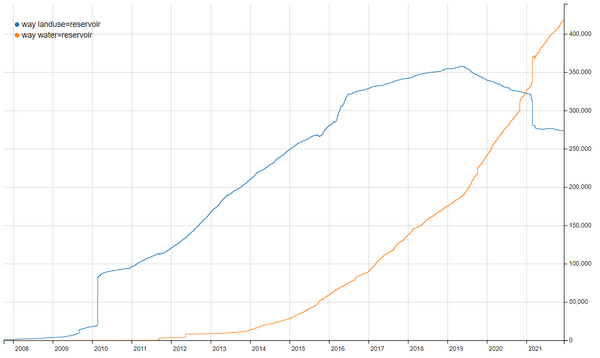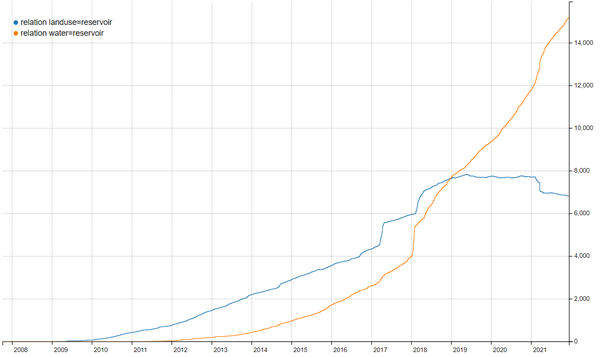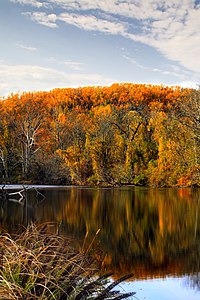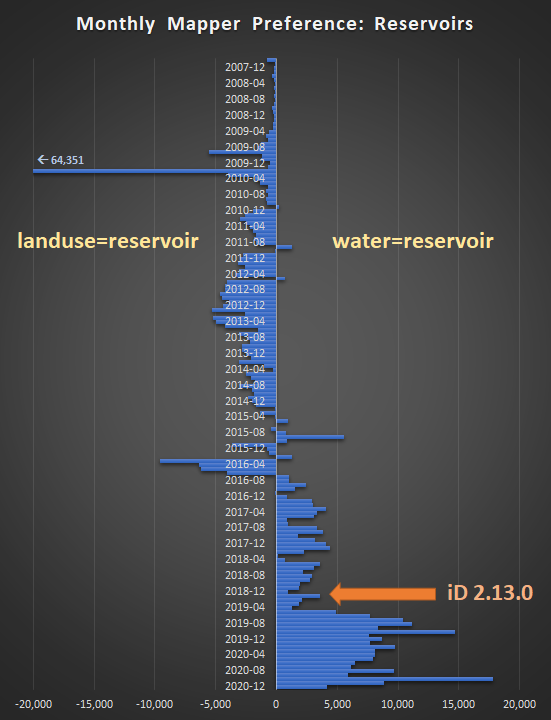Proposal:Reservoir (2020)
| Deprecation of landuse=reservoir | |
|---|---|
| Proposal status: | Approved (active) |
| Proposed by: | ZeLonewolf |
| Tagging: | water=reservoir
|
| Applies to: | |
| Definition: | An artificially-created or enlarged body of water created using a dam to store water for human use. |
| Statistics: |
|
| Rendered as: | 
|
| Draft started: | 2020-12-16 |
| RFC start: | 2020-12-20 |
| Vote start: | 2022-01-16 |
| Vote end: | 2022-01-31 |
Proposal
This proposes that:
- The tag
landuse=reservoiris deprecated, and replaced withnatural=water+water=reservoir, which was approved in 2011. - The key
reservoir_type=water_storageis deprecated as discardable once the feature is taggednatural=water+water=reservoir. - Definitions are adopted, as described in the following sections, for:
| Deprecated Tag | Replacement |
|---|---|
landuse=reservoir
|
natural=water + water=reservoir
|
reservoir_type=water_storage
|
None. This tag can be safely removed. |
Definitions
Mappers should tag lakes, ponds, and reservoirs (which often have similar appearance on imagery) as natural=water. If they are able to further determine the specific type of waterbody, water=* can also be applied. Definitions for three of these values (reservoir, lake, and pond) are described below.
Reservoir
A reservoir is an artificially-created or enlarged body of water created using a dam to store water for human use. Dam, in this context, specifically refers to a man-made structure which allows for human control of the reservoir water level and downstream water flow. (See: ![]() Reservoir).
Reservoir).
Reservoirs are be tagged with natural=water + water=reservoir.
Reservoirs include the following types:
- Dammed valleys rely on the natural topography to provide most of the body of the reservoir. A dam is typically located at a narrow part of a valley downstream of a natural basin. Sometimes additional side dams are required to contain the reservoir. In hilly regions, reservoirs may be constructed by enlarging existing lakes.
- Coastal reservoirs are fresh water storage reservoirs located on the sea coast near the river mouth to store the flood water of a river. Many coastal reservoirs were constructed in Asia and Europe.
- Bank-side reservoirs, where water is pumped or siphoned from a river to store the water. Such reservoirs are usually formed partly by excavation and sometimes by building an encircling
 levee or embankment.
levee or embankment.
Reservoirs are used for multiple purposes:
- Water supply. Many reservoirs are used to provide the raw water feed to a water treatment plant which delivers drinking water through water mains, or irrigation water used by agriculture.
- Hydroelectricity. A reservoir generating hydroelectricity includes turbines connected to the retained water body by large-diameter pipes. These generating sets may be at the base of the dam or some distance away. In a pump storage facility, both the upper and lower reservoirs should be tagged as a reservoir.
- Controlling watersources. Reservoirs can be used to control water flow in downstream waterways:
- Water may be released from an upland reservoir so that it can be used downstream for drinking, irrigation, etc.
- Flood control and flow balancing reservoirs collect water at times of high flow, then release it slowly during the following weeks or months.
- Water may be released from a reservoir to supplement white water conditions for white-water sports, or to encourage natural migration behaviours in fish
- Recreation. Many reservoirs often allow some recreational uses, such as fishing and boating. Recreation is usually a secondary use of reservoirs that are used for hydroelectric generation or irrigation, however there are some cases of reservoirs which are purely recreational.
- Navigation. It is common on large navigable rivers (for example, the Mississippi River in the USA) to create a series of subsequent reservoirs with dams and locks to allow for waterborne navigation. The dam in this case removes rapids and creates a level surface for boats. In cases where these dam/lock systems meaningfully widen the river into a larger named water body, this should be tagged as a reservoir.
- Cooling. Also known as a cooling pond, a cooling reservoir is a man-made body of water primarily formed for the purpose of cooling heated water and/or to store and supply cooling water to a nearby power plant or industrial facility such as a petroleum refinery, pulp and paper mill, chemical plant, steel mill or smelter.
Additional clarification:
- Service reservoirs are used for storage of potable drinking water close to the point of distribution. While these are called "reservoirs" in water systems jargon, these are usually not open bodies of water, but rather a storage tank, cistern, basin or a water tower, and thus should be tagged instead as
man_made=storage_tank,water=basin/landuse=basinorman_made=water_toweras appropriate. - Bodies of water with dams that do not fit the description above should not be tagged as reservoirs, and should instead be tagged with
water=lakeorwater=pondinstead. This includes:- Bodies of water created by beaver dams
- Ponds created for decorative or aesthetic landscaping purposes
- Structures which were historically used for water-powered machinery, such as a
 Mill pond
Mill pond
- Bodies of water created by a weir (
waterway=weir) are not reservoirs, as these structures do not have flow control. A reservoir may include weirs for grade separation between sections of a reservoir, however the most downstream outlet must be a dam with flow control. - Bodies of water which are functionally reservoirs, may still carry nomenclature that includes "Lake", "Pond", or similar terminology in the local language. For example, Johnson's Pond
 Johnson's Pond is a reservoir that's also known on official maps as Flat River Reservoir, and it has a dam holding water primarily for recreation. Since this body of water is functionally a reservoir, it's tagged as a reservoir and not as a pond.
Johnson's Pond is a reservoir that's also known on official maps as Flat River Reservoir, and it has a dam holding water primarily for recreation. Since this body of water is functionally a reservoir, it's tagged as a reservoir and not as a pond.
Lakes and Ponds
A lake or a pond is a naturally-occurring or artificial inland body of water. There is no precise difference between a lake or a pond. The definitions below are provided as guidelines for mappers to make the determination of which tag to use. Note that some bodies of water may exhibit aspects of both lists; local mappers should make a determination which definition is the best fit.
Lakes are tagged natural=water + water=lake. Lakes, in the context of OpenStreetMap:
- Are not a reservoir (see definition above)
- Not a basin (see
landuse=basin,water=basin, andbasin=*) - Are usually larger than 8-20 hectares (80,000-200,000 m²) in size
- Often named with "lake" (or local language equivalent) in the name
- Have areas of deep water that receive no sunlight, preventing plant growth (see
 Aphotic zone)
Aphotic zone)
Ponds are tagged natural=water + water=pond. Ponds, in the context of OpenStreetMap, are:
- Not a reservoir (see definition above)
- Not a basin (see
landuse=basin,water=basin, andbasin=*) - Not an evaporation pond; these are tagged as a basin, with the approved tag
basin=evaporation - Not a salt evaporation pond; the separate tag
landuse=salt_pondis used to tag these features, which are used to extract salt from saltwater. - Not used for holding contents other than water. During the community discussions around the approved proposal for tailings pond tagging, there was a community consensus that bodies of liquid other than water should not be tagged as water. Thus ponds are:
- Not a tailings pond; these are tagged with the approved tag
man_made=tailings_pond - Not a manure or sewage pond
- Not a tailings pond; these are tagged with the approved tag
- Lacking wave action at the shoreline
- Are usually no more than 8-20 hectares (80,000-200,000 m²) in size
- Often named with "pond" (or local language equivalent) in the name
- Shallow enough for sunlight to reach the bottom or to allow rooted plants to grow throughout it (see
 Photic zone)
Photic zone)
Note that:
- Some naturally-occurring lakes or ponds may have a regulating dam or weir at its outlet which does not meaningfully change the size of the water body, but rather was built to minimize seasonal variations in water level on the lake or outlet stream, or to provide hydroelectric power generation from an existing natural lake. These lakes and ponds are not reservoirs merely because of the presence of outflow regulating infrastructure.
 Flathead Lake in Montana USA is one such example of this; while the added hydroelectric dam raised the lake level by 3 meters, this only represented a small increase in the size of the existing natural lake.
Flathead Lake in Montana USA is one such example of this; while the added hydroelectric dam raised the lake level by 3 meters, this only represented a small increase in the size of the existing natural lake.  Stream pools and
Stream pools and  plunge pools, which are bodies of water that naturally occur along the course of the waterway, are covered by the existing tag
plunge pools, which are bodies of water that naturally occur along the course of the waterway, are covered by the existing tag water=stream_pool, and are not considered ponds.- Because the distinction between a lake and a pond is imprecise, "vanity naming" sometimes occurs. For example, a real estate developer may construct a pond as part of a housing development but name it as lake for marketing purposes.
- The question of how to tag a
 quarry lake is unresolved. A mailing discussion on this topic showed that there is disagreement as to whether quarry lakes should be tagged with
quarry lake is unresolved. A mailing discussion on this topic showed that there is disagreement as to whether quarry lakes should be tagged with water=lakeor with some other key such aswater=quarry_lake. Commenters noted that quarry lakes had unique characteristics that made them distinct from other types of lakes. However, other commenters noted the difficulty of determining the quarry origin of a lake, particularly for older or even ancient quarries. Because there does not appear to be a firm consensus either way, the question of how to tag these bodies of water is deliberately left unresolved by this proposal. - Cattle ponds, cattle troughs, farm ponds, stock tanks, watering holes, or turkey nest dams are often dug along a stream on farms or ranches, in order to capture water for livestock. Since these ponds do not have any regulating outflow mechanism (water flows freely into and out of the pond), they should be tagged as a pond. In some parts of the southwestern United States, these cattle ponds are known as "cattle tanks". However, in other areas, "cattle tanks" refer to a plastic or metal container that holds water. This latter definition of "cattle tank" should instead be tagged as appropriate for a water container, for example
man_made=water_tank.
Meaning of "Deprecated"
Specifically, in this context the term deprecated means:
- The OSM community recommends
natural=water+water=reservoiras a drop-in replacement forlanduse=reservoir - The deprecation template will be added to the wiki page for
landuse=reservoir - The tag
landuse=reservoirwill be added to Deprecated features - The tag
landuse=reservoirwill remain listed on Map features until it is no longer used. - Data consumers are recommended to support both tags until such time as
landuse=reservoiris no longer in use
| Under no circumstances should you automatically (or semi-automatically) change "deprecated" tags to something else in the database on a large scale without conforming to the Automated Edits code of conduct. Any such edits will be reverted. |
Background
The 2011 proposal Water details approved the new key water=*. Specifically, it proposed the combination of natural=water + water=reservoir as the replacement for landuse=reservoir. The purpose of that proposal included the following rationale:
- "For areas tagged with
natural=waterit should be possible to mark which type of water body it is." - "[...] reservoirs should be tagged consistently with other water bodies, using
natural=water."
Since water=* was a new key, it was recommended in that proposal that mappers tag both water=reservoir and landuse=reservoir in order for data consumer to begin adopting the new tagging. Over time, a debate emerged as to whether landuse=reservoir was deprecated or whether this 2011 proposal intended to create a fully parallel tagging scheme for reservoirs. This proposal ends that ambiguity by affirming the intent of the 2011 proposal by declaring that landuse=reservoir is deprecated.
Rationale
- A land tag should not be used to tag a water feature. Map features describes the
landuse=*key as describing "the purpose for which an area of land is being used." - Mappers should be able to tag visible water features with
natural=waterwithout having to determine in advance whether or not it is a reservoir. Withlanduse=reservoir, a mapper must first determine whether or not a body of water is a reservoir before deciding which tag to use. - Mappers have preferred the use of
water=reservoiroverlanduse=reservoirin recent years. Since 2016, usage ofwater=reservoirhas increased by 241,066 whilelanduse=reservoirhas decreased by 2,403. (data as of 12/19/20) This suggests that mappers are usingwater=reservoirfor mapping new reservoirs, while slowly replacing existing usages oflanduse=reservoir. - Mappers have preferred since
water=reservoiroverlanduse=reservoirsince mid-2016, 2.5 years before the introduction of changes to iD editor presets in favor of thewater=*tag. The iD preset change merely accelerated an existing mapper preference forwater=*over alternative schemes. - There is a need for formal definitions in order to clarify what exactly a
water=reservoiris, and how it differs fromwater=lakeandwater=pond. - Despite the lack of a clear distinction between lakes and ponds in the real world, mailing list discussions have indicated that there is community support for maintaining a distinction between them, even if that distinction involves a degree of subjective judgement on the part of mappers.
- The only known data user that does not have support for the
water=*tag is openmap.lt, which has not been actively developed since 2012.
Tagging Analysis
Data from taginfo API as of 18 Feb 2021
This table does not include nodes. There are an additional 50,000 nodes tagged landuse=reservoir resulting from the 2008 GNIS import in the United States which have not yet been traced into areas.
| Year | landuse=reservoir
|
Comparison | water=reservoir
| ||||
|---|---|---|---|---|---|---|---|
| # Areas | Change | Preference | Change | Usage Ratio | Change | # Areas | |
| 2021 | 322,251 | 25,728 |
18,386 |
347,979 | |||
| 2020 | 329,831 | 7,342 |
104,053 |
337,173 | |||
| 2019 | 347,428 | 83,022 |
250,717 | ||||
| 2018 | 362,279 | 26,685 |
1:2.83 | 182,546 | |||
| 2017 | 347,704 | 34,614 |
1:3.36 | 141,286 | |||
| 2016 | 333,049 | 1.59:1 | 92,017 | ||||
| 2015 | 283,586 | 1.01:1 | 60,948 | ||||
| 2014 | 251,707 | 2.61:1 | 29,231 | ||||
| 2013 | 211,919 | 8.43:1 | 13,970 | ||||
| 2012 | 167,784 | 8.85:1 | 8,735 | ||||
| 2011 | 120,834 | 7.12:1 | 3,427 | ||||
| 2010 | 96,453 | 78517.00:1 | 1 | ||||
| 2009 | 17,936 | ?:1 | 0 | 0 | |||
| 2008 | 3,509 | ?:1 | 0 | 0 | |||
| 2007 | 1,028 | ?:1 | 0 | 0 | |||
Graphical Analysis
These graphs shows the usage of the two tags over time. There is a clear trend towards the use of water=* tags. The first graph compares way tagging, and the second graph compares relation tagging.
Tagging of water=reservoir vs landuse=reservoir over time
|
|---|

|
Tagging of water=reservoir vs landuse=reservoir over time
|
|---|

|
iD 2.13.0 Preset Change
By mid-2016, mappers began consistently favoring the use of water=reservoir over landuse=reservoir. The graphic below shows the difference in monthly change in area tagging between the two tags.
On December 11, 2018, a new issue was opened in the iD editor's issue tracker to change that editor's presets to use the water=* scheme rather than competing alternatives. This change took effect with version 2.13.0, released Jan 23, 2019.
A few months after this iD editor preset change, mappers began consistently favoring the use of water=reservoir in much larger numbers.
Examples

|
Loch Raven Reservoir |
|---|---|
The following listing demonstrates the various types of reservoirs described above.
Dammed valleys
- Lake Mead
 Lake Mead, a dammed valley and the largest reservoir in the United States.
Lake Mead, a dammed valley and the largest reservoir in the United States. - Llyn Clywedog
 Llyn Clywedog in Wales, a dammed valley in which additional side dams are required to contain the reservoir.
Llyn Clywedog in Wales, a dammed valley in which additional side dams are required to contain the reservoir. - Llwyn-on
 Llwyn-on, Cantref
Llwyn-on, Cantref Cantref and Beacons Reservoirs
Cantref and Beacons Reservoirs Beacons Reservoirs are examples of a chain of reservoirs in the
Beacons Reservoirs are examples of a chain of reservoirs in the  River Taff valley.
River Taff valley.
Coastal Reservoirs
- Marina Barrage
 Marina Barrage in Singapore
Marina Barrage in Singapore - Qingcaosha
 Qingcaosha in China
Qingcaosha in China - Plover Cove
 Plover Cove in Hong Kong
Plover Cove in Hong Kong
Bank-side Reservoirs
- Queen Mary Reservoir
 Queen Mary Reservoir in the United Kingdom
Queen Mary Reservoir in the United Kingdom
Flood control Reservoirs
- Lake Burrendong
 Lake Burrendong in Australia
Lake Burrendong in Australia - Bala Lake (Llyn Tegid)
 Bala Lake (Llyn Tegid) in North Wales
Bala Lake (Llyn Tegid) in North Wales
Reservoirs used for hydro-electric power generation
- Lake Mead
 Lake Mead in Nevada, USA
Lake Mead in Nevada, USA - Marchlyn Mawr
 Marchlyn Mawr and Llyn Peris
Marchlyn Mawr and Llyn Peris Llyn Peris in Wales, United Kingdom
Llyn Peris in Wales, United Kingdom
Reservoirs used for drinking water
- Iskar Reservoir
 Iskar Reservoir in Bulgaria
Iskar Reservoir in Bulgaria
Reservoirs used for recreation
- Dry Falls Lake
 Dry Falls Lake in the state of Washington, USA.
Dry Falls Lake in the state of Washington, USA. - Oswego Lake
 Oswego Lake in Oregon, USA. While this reservoir was originally created for industrial purposes, it is now used for recreation.
Oswego Lake in Oregon, USA. While this reservoir was originally created for industrial purposes, it is now used for recreation.
Cooling reservoirs
- Mount Storm Lake
 Mount Storm Lake in the state of West Virginia, USA, which services the Mount Storm Power Station
Mount Storm Lake in the state of West Virginia, USA, which services the Mount Storm Power Station Mount Storm Power Station.
Mount Storm Power Station.
Applies to
Rendering
It is recommended that data consumers and renderers continue to support both landuse=reservoir and natural=water + water=reservoir until such time as landuse=reservoir use drops to insignificant levels.
Features/Pages affected
| Page | Action |
|---|---|
landuse=reservoir
|
Mark this tag as deprecated, and add it to Deprecated features |
| Update definitions on their respective wiki pages | |
reservoir_type=water_storage
|
Mark this tag as deprecated and discardable, and add it to Deprecated features. |
External discussions
- Dec 2020 [tagging] Quarry lakes
- Dec 2020 [tagging] Feature Proposal - RFC - Reservoirs, lakes, and ponds
- Dec 2020 [tagging] The saga of landuse=reservoir vs water=reservoir - tagging mailing list, 2020 thread
- Nov 2020 [tagging] deprecate water=pond?
- Jul 2020 [tagging] Riverbanks
- Mar 2020 [tagging] Ponds are not observable on the ground
- Nov 2019 Changeset 76766631 discussion (author: pangoSE)
- Jul 2019 [JOSM ticket] Proposal to introduce the same retagging rule into JOSM
- Jun 2019 [talk] iD forces mistagging again
- Jun 2019 [talk-lt] iD redaktoriaus problemos (iD editor problems)
- Jun 2019 [tagging] landuse=reservoir vs water=reservoir
- Jun 2019 [iD github] iD is forcing retaging from landuse=reservoir to natural=water+water=reservoir
- Apr 2019 [talk] iD influencing tagging
- Oct 2018 [talk-it] landuse=reservoir
- Sep 2018 [tagging] My weirdly unnatural aversion to relations
- Jul 2018 [tagging] landuse=basin
- Mar 2017 [tagging] water=pool
- Jun 2016 [talk] Failed water proposal reversal
- Feb 2015 [tagging] How to tag a cistern?
- Jan 2015 [tagging] Adding water=fishpond to the wiki
- Jun 2013 [tagging] When was landuse=reservoir deprecated?
- Jun 2013 [JOSM ticket] Reservoir preset is using a deprecated tag
- Nov 2012 [talk-it] Tag:landuse=reservoir
- May 2012 [talk-lt] Vandens telkiniai (Water bodies)
- Jan 2012 [tagging] Health and other stories
- Sep 2011 [tagging] water=*
- May 2011 [tagging] Requirements for proposals and voting to be valid
- Apr 2011 [tagging] New proposal: water=* (voting announcement)
- Apr 2011 [tagging] New proposal: water=*
- Jan 2008 [talk] RFC - lake
Voting
Voting on this proposal has been closed.
It was approved with 54 votes for, 0 votes against and 0 abstentions.
 I approve this proposal. I support deprecating
I approve this proposal. I support deprecating landuse=reservoirand providing expanded definitions for lake and pond. --ZeLonewolf (talk) 15:10, 16 January 2022 (UTC) I approve this proposal. --Mateusz Konieczny (talk) 15:18, 16 January 2022 (UTC)
I approve this proposal. --Mateusz Konieczny (talk) 15:18, 16 January 2022 (UTC) I approve this proposal. unsigned vote by Jumbanho
I approve this proposal. unsigned vote by Jumbanho I approve this proposal. Nicely crafted! --Penegal (talk) 15:34, 16 January 2022 (UTC)
I approve this proposal. Nicely crafted! --Penegal (talk) 15:34, 16 January 2022 (UTC) I approve this proposal. --Cartographer10 (talk) 15:37, 16 January 2022 (UTC)
I approve this proposal. --Cartographer10 (talk) 15:37, 16 January 2022 (UTC) I approve this proposal. Rjgambrel (talk) 15:39, 16 January 2022 (UTC)
I approve this proposal. Rjgambrel (talk) 15:39, 16 January 2022 (UTC) I approve this proposal. --Aweech (talk) 15:43, 16 January 2022 (UTC)
I approve this proposal. --Aweech (talk) 15:43, 16 January 2022 (UTC) I approve this proposal. --Bradrh (talk) 16:07, 16 January 2022 (UTC)
I approve this proposal. --Bradrh (talk) 16:07, 16 January 2022 (UTC) I approve this proposal. --Rayleigh1 (talk) 16:18, 16 January 2022 (UTC)
I approve this proposal. --Rayleigh1 (talk) 16:18, 16 January 2022 (UTC) I approve this proposal. --Mashin (talk) 16:21, 16 January 2022 (UTC)
I approve this proposal. --Mashin (talk) 16:21, 16 January 2022 (UTC) I approve this proposal. --Riiga (talk) 16:29, 16 January 2022 (UTC)
I approve this proposal. --Riiga (talk) 16:29, 16 January 2022 (UTC) I approve this proposal. --pkoby (talk) 16:34, 16 January 2022 (UTC)
I approve this proposal. --pkoby (talk) 16:34, 16 January 2022 (UTC) I approve this proposal. --AntMadeira (talk) 16:37, 16 January 2022 (UTC)
I approve this proposal. --AntMadeira (talk) 16:37, 16 January 2022 (UTC) I approve this proposal. --Kjon (talk) 16:40, 16 January 2022 (UTC)
I approve this proposal. --Kjon (talk) 16:40, 16 January 2022 (UTC) I approve this proposal. --Alexmol (talk) 16:54, 16 January 2022 (UTC)
I approve this proposal. --Alexmol (talk) 16:54, 16 January 2022 (UTC) I approve this proposal. --Endim8 (talk) 17:32, 16 January 2022 (UTC)
I approve this proposal. --Endim8 (talk) 17:32, 16 January 2022 (UTC) I approve this proposal. --MoiraPrime (talk) 18:45, 16 January 2022 (UTC)
I approve this proposal. --MoiraPrime (talk) 18:45, 16 January 2022 (UTC) I approve this proposal. Mainly for reason provided in rationale nr 2. --Fghj753 (talk) 18:50, 16 January 2022 (UTC)
I approve this proposal. Mainly for reason provided in rationale nr 2. --Fghj753 (talk) 18:50, 16 January 2022 (UTC) I approve this proposal. --Emilius123 (talk) 19:10, 16 January 2022 (UTC)
I approve this proposal. --Emilius123 (talk) 19:10, 16 January 2022 (UTC) I approve this proposal. --Carnildo (talk) 19:50, 16 January 2022 (UTC)
I approve this proposal. --Carnildo (talk) 19:50, 16 January 2022 (UTC) I approve this proposal. --MapSpot (talk) 19:52, 16 January 2022 (UTC)
I approve this proposal. --MapSpot (talk) 19:52, 16 January 2022 (UTC) I approve this proposal. Reservoirs and other bodies of water should have a consistent tagging scheme. -BubbaJuice (talk) 20:02, 16 January 2022 (UTC)
I approve this proposal. Reservoirs and other bodies of water should have a consistent tagging scheme. -BubbaJuice (talk) 20:02, 16 January 2022 (UTC) I approve this proposal. --Protoxenus (talk) 20:29, 16 January 2022 (UTC)
I approve this proposal. --Protoxenus (talk) 20:29, 16 January 2022 (UTC) I approve this proposal. --maro21 20:53, 16 January 2022 (UTC)
I approve this proposal. --maro21 20:53, 16 January 2022 (UTC) I approve this proposal. --Woazboat (talk) 21:14, 16 January 2022 (UTC)
I approve this proposal. --Woazboat (talk) 21:14, 16 January 2022 (UTC) I approve this proposal. --Jdcarls2 (talk) 21:29, 16 January 2022 (UTC)
I approve this proposal. --Jdcarls2 (talk) 21:29, 16 January 2022 (UTC) I approve this proposal. Well researched, detailed, and well-worded. Excellent proposal. Eiim (talk) 22:19, 16 January 2022 (UTC)
I approve this proposal. Well researched, detailed, and well-worded. Excellent proposal. Eiim (talk) 22:19, 16 January 2022 (UTC) I approve this proposal. -- Ezekielf (talk) 22:32, 16 January 2022 (UTC)
I approve this proposal. -- Ezekielf (talk) 22:32, 16 January 2022 (UTC) I approve this proposal. -- ke9tv (talk) 23:00, 16 January 2022 (UTC)
I approve this proposal. -- ke9tv (talk) 23:00, 16 January 2022 (UTC) I approve this proposal. --Rskedgell (talk) 23:05, 16 January 2022 (UTC)
I approve this proposal. --Rskedgell (talk) 23:05, 16 January 2022 (UTC) I approve this proposal. --Phidauex (talk) 23:16, 16 January 2022 (UTC) Well developed plan over a long period of time, with clear implementation path. Lets do it!
I approve this proposal. --Phidauex (talk) 23:16, 16 January 2022 (UTC) Well developed plan over a long period of time, with clear implementation path. Lets do it! I approve this proposal. --Polarbear w (talk) 00:16, 17 January 2022 (UTC)
I approve this proposal. --Polarbear w (talk) 00:16, 17 January 2022 (UTC) I approve this proposal. To quote Eiim above, "Well researched, detailed, and well-worded. Excellent proposal." --Dr Centerline (talk) 01:00, 17 January 2022 (UTC)
I approve this proposal. To quote Eiim above, "Well researched, detailed, and well-worded. Excellent proposal." --Dr Centerline (talk) 01:00, 17 January 2022 (UTC) I approve this proposal. --Fizzie41 (talk) 01:39, 17 January 2022 (UTC)
I approve this proposal. --Fizzie41 (talk) 01:39, 17 January 2022 (UTC) I approve this proposal. --Adiatmad (talk) 03:22, 17 January 2022 (UTC)
I approve this proposal. --Adiatmad (talk) 03:22, 17 January 2022 (UTC) I approve this proposal. --Eginhard (talk) 07:29, 17 January 2022 (UTC)
I approve this proposal. --Eginhard (talk) 07:29, 17 January 2022 (UTC) I approve this proposal. --501ghost (talk) 08:42, 17 January 2022 (UTC)
I approve this proposal. --501ghost (talk) 08:42, 17 January 2022 (UTC) I approve this proposal. Deprecate another _type key? Yes I do! --Fanfouer (talk) 13:28, 17 January 2022 (UTC)
I approve this proposal. Deprecate another _type key? Yes I do! --Fanfouer (talk) 13:28, 17 January 2022 (UTC) I approve this proposal. --Dimitar155 (talk) 18:14, 17 January 2022 (UTC)
I approve this proposal. --Dimitar155 (talk) 18:14, 17 January 2022 (UTC) I approve this proposal. Very well made proposal. Much better because now all bodies of water have the same tag. Why make reservoirs landuses when all other bodies of water are just water= anyway. --Aaro Hart (talk) 19:20, 17 January 2022 (UTC)
I approve this proposal. Very well made proposal. Much better because now all bodies of water have the same tag. Why make reservoirs landuses when all other bodies of water are just water= anyway. --Aaro Hart (talk) 19:20, 17 January 2022 (UTC) I approve this proposal. Thorough, well-researched, and convincing—an exemplary proposal. — Jake Low (talk) 19:43, 17 January 2022 (UTC)
I approve this proposal. Thorough, well-researched, and convincing—an exemplary proposal. — Jake Low (talk) 19:43, 17 January 2022 (UTC) I approve this proposal. --Adamfranco (talk) 01:49, 18 January 2022 (UTC)
I approve this proposal. --Adamfranco (talk) 01:49, 18 January 2022 (UTC) I approve this proposal. --Himké (talk) 02:14, 18 January 2022 (UTC)
I approve this proposal. --Himké (talk) 02:14, 18 January 2022 (UTC) I approve this proposal. Excellent proposal, well done. --Marczoutendijk (talk) 20:57, 18 January 2022 (UTC)
I approve this proposal. Excellent proposal, well done. --Marczoutendijk (talk) 20:57, 18 January 2022 (UTC) I approve this proposal. --Peter Elderson (talk) 12:20, 19 January 2022 (UTC)
I approve this proposal. --Peter Elderson (talk) 12:20, 19 January 2022 (UTC)
 I approve this proposal. Although with one suggestion for for a change in definition, added to the discussion page. --Harahu (talk) 12:41, 22 January 2022 (UTC)
I approve this proposal. Although with one suggestion for for a change in definition, added to the discussion page. --Harahu (talk) 12:41, 22 January 2022 (UTC) I approve this proposal. --Hokko-sha (talk) 05:52, 23 January 2022 (UTC)
I approve this proposal. --Hokko-sha (talk) 05:52, 23 January 2022 (UTC) I approve this proposal. --Duja (talk) 17:45, 26 January 2022 (UTC)
I approve this proposal. --Duja (talk) 17:45, 26 January 2022 (UTC) I approve this proposal. --Tjuro (talk) 19:41, 26 January 2022 (UTC)
I approve this proposal. --Tjuro (talk) 19:41, 26 January 2022 (UTC) I approve this proposal. --Meme (talk) 02:59, 28 January 2022 (UTC)
I approve this proposal. --Meme (talk) 02:59, 28 January 2022 (UTC) I approve this proposal. This is a clearly written proposal that makes OSM more robust and easier for noth contributors and users to work with. --Andrew (talk) 21:43, 29 January 2022 (UTC)
I approve this proposal. This is a clearly written proposal that makes OSM more robust and easier for noth contributors and users to work with. --Andrew (talk) 21:43, 29 January 2022 (UTC) I approve this proposal. --Izolight (talk) 09:27, 31 January 2022 (UTC)
I approve this proposal. --Izolight (talk) 09:27, 31 January 2022 (UTC) I approve this proposal. --SherbetS (talk) 13:42, 31 January 2022 (UTC)
I approve this proposal. --SherbetS (talk) 13:42, 31 January 2022 (UTC) I approve this proposal. --Schröcker (talk) 22:33, 31 January 2022 (UTC)
I approve this proposal. --Schröcker (talk) 22:33, 31 January 2022 (UTC)
Comments
Please comment on the discussion page.
